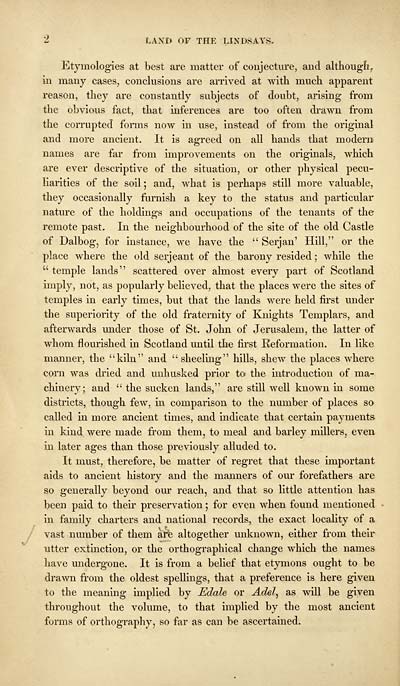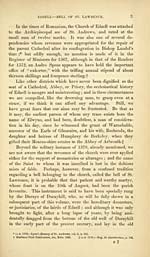Download files
Complete book:
Individual page:
Thumbnail gallery: Grid view | List view

2 LAND OF THE LINDSAYS,
Etymologies at best are matter of conjecture, and although,
in many cases, conclusions are arrived at with much apparent
reason, they are constantly subjects of doubt, arising from
the obvious fact, that inferences are too often drawn from
the corrupted forms now in use, instead of from the original
and more ancient. It is agreed on all hands that modern
names are far from improvements on the originals, which
are ever descriptive of the situation, or other physical pecu-
liarities of the soil; and, what is perhaps still more valuable,
they occasionally furnish a key to the status and particular
nature of the holdings and occupations of the tenants of the
remote past. In the neighbourhood of the site of the old Castle
of Dalbog, for instance, we have the " Serjan' Hill," or the
place where the old serjeant of the barony resided ; while the
" temple lands" scattered over almost every part of Scotland
imply, not, as popularly believed, that the places were the sites of
temples in early times, but that the lands were held first under
the superiority of the old fraternity of Knights Templars, and
afterwards under those of St. John of Jerusalem, the latter of
whom flourished in Scotland until the first Reformation. In like
manner, the "kiln" and "sheeling" hills, shew the places where
corn was dried and unhusked prior to the introduction of ma-
chinery; and " the sucken lands," are still well known in some
districts, though few, in comparison to the number of places so
called in more ancient times, and indicate that certain payments
in kind were made from them, to meal and barley millers, even
in later ages than those previously alluded to.
It must, therefore, be matter of regret that these important
aids to ancient history and the manners of our forefathers are
so generally beyond our reach, and that so little attention has
been paid to their preservation ; for even when found mentioned
in family charters and national records, the exact locality of a
vast number of them are altogether unknown, either from their
utter extinction, or the orthographical change which the names
have undergone. It is from a belief that etymons ought to be
drawn from the oldest spellings, that a preference is here given
to the meaning implied by Edale or Adel, as will be given
throughout the volume, to that implied by the most ancient
forms of orthography, so far as can be ascertained.
Etymologies at best are matter of conjecture, and although,
in many cases, conclusions are arrived at with much apparent
reason, they are constantly subjects of doubt, arising from
the obvious fact, that inferences are too often drawn from
the corrupted forms now in use, instead of from the original
and more ancient. It is agreed on all hands that modern
names are far from improvements on the originals, which
are ever descriptive of the situation, or other physical pecu-
liarities of the soil; and, what is perhaps still more valuable,
they occasionally furnish a key to the status and particular
nature of the holdings and occupations of the tenants of the
remote past. In the neighbourhood of the site of the old Castle
of Dalbog, for instance, we have the " Serjan' Hill," or the
place where the old serjeant of the barony resided ; while the
" temple lands" scattered over almost every part of Scotland
imply, not, as popularly believed, that the places were the sites of
temples in early times, but that the lands were held first under
the superiority of the old fraternity of Knights Templars, and
afterwards under those of St. John of Jerusalem, the latter of
whom flourished in Scotland until the first Reformation. In like
manner, the "kiln" and "sheeling" hills, shew the places where
corn was dried and unhusked prior to the introduction of ma-
chinery; and " the sucken lands," are still well known in some
districts, though few, in comparison to the number of places so
called in more ancient times, and indicate that certain payments
in kind were made from them, to meal and barley millers, even
in later ages than those previously alluded to.
It must, therefore, be matter of regret that these important
aids to ancient history and the manners of our forefathers are
so generally beyond our reach, and that so little attention has
been paid to their preservation ; for even when found mentioned
in family charters and national records, the exact locality of a
vast number of them are altogether unknown, either from their
utter extinction, or the orthographical change which the names
have undergone. It is from a belief that etymons ought to be
drawn from the oldest spellings, that a preference is here given
to the meaning implied by Edale or Adel, as will be given
throughout the volume, to that implied by the most ancient
forms of orthography, so far as can be ascertained.
Set display mode to:
![]() Universal Viewer |
Universal Viewer | ![]() Mirador |
Large image | Transcription
Mirador |
Large image | Transcription
Images and transcriptions on this page, including medium image downloads, may be used under the Creative Commons Attribution 4.0 International Licence unless otherwise stated. ![]()
| Histories of Scottish families > History and traditions of the land of the Lindsays in Angus and Mearns > (20) Page 2 |
|---|
| Permanent URL | https://digital.nls.uk/94869266 |
|---|
| Description | A selection of almost 400 printed items relating to the history of Scottish families, mostly dating from the 19th and early 20th centuries. Includes memoirs, genealogies and clan histories, with a few produced by emigrant families. The earliest family history goes back to AD 916. |
|---|
![[Page 1]](https://deriv.nls.uk/dcn4/9486/94869256.4.jpg)
